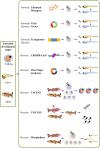Zebrafish: an emerging real-time model system to study Alzheimer's disease and neurospecific drug discovery
- PMID: 30302279
- PMCID: PMC6170431
- DOI: 10.1038/s41420-018-0109-7
Zebrafish: an emerging real-time model system to study Alzheimer's disease and neurospecific drug discovery
Erratum in
-
Erratum: Publisher Correction: articles initially published in wrong volume.Cell Death Discov. 2019 Jul 10;5:116. doi: 10.1038/s41420-019-0186-2. eCollection 2019. Cell Death Discov. 2019. PMID: 31312525 Free PMC article.
Abstract
Zebrafish (Danio rerio) is emerging as an increasingly successful model for translational research on human neurological disorders. In this review, we appraise the high degree of neurological and behavioural resemblance of zebrafish with humans. It is highly validated as a powerful vertebrate model for investigating human neurodegenerative diseases. The neuroanatomic and neurochemical pathways of zebrafish brain exhibit a profound resemblance with the human brain. Physiological, emotional and social behavioural pattern similarities between them have also been well established. Interestingly, zebrafish models have been used successfully to simulate the pathology of Alzheimer's disease (AD) as well as Tauopathy. Their relatively simple nervous system and the optical transparency of the embryos permit real-time neurological imaging. Here, we further elaborate on the use of recent real-time imaging techniques to obtain vital insights into the neurodegeneration that occurs in AD. Zebrafish is adeptly suitable for Ca2+ imaging, which provides a better understanding of neuronal activity and axonal dystrophy in a non-invasive manner. Three-dimensional imaging in zebrafish is a rapidly evolving technique, which allows the visualisation of the whole organism for an elaborate in vivo functional and neurophysiological analysis in disease condition. Suitability to high-throughput screening and similarity with humans makes zebrafish an excellent model for screening neurospecific compounds. Thus, the zebrafish model can be pivotal in bridging the gap from the bench to the bedside. This fish is becoming an increasingly successful model to understand AD with further scope for investigation in neurodevelopment and neurodegeneration, which promises exciting research opportunities in the future.
Conflict of interest statement
The authors declare that they have no conflict of interest.
Figures


References
-
- Detrich HW, 3rd, Westerfield M, Zon LI. Overview of the Zebrafish system. Methods Cell Biol. 1999;59:3–10. - PubMed
-
- Cooper MS, D’Amico LA, Henry CA. Analyzing morphogenetic cell behaviors in vitally stained zebrafish embryos. Methods Mol. Biol. 1999;122:185–204. - PubMed
-
- Cooper MS, D’Amico LA, Henry CA. Confocal microscopic analysis of morphogenetic movements. Methods Cell Biol. 1999;59:179–204. - PubMed
-
- Kimmel CB. Genetics and early development of zebrafish. Trends Genet. 1989;5:283–288. - PubMed
LinkOut - more resources
Full Text Sources
Miscellaneous

